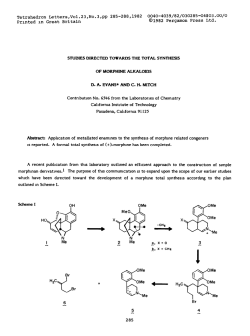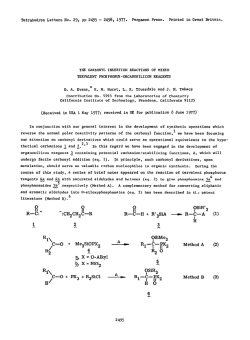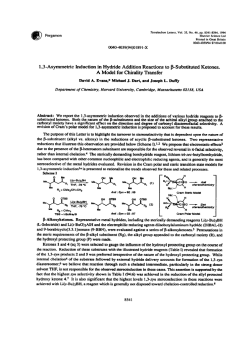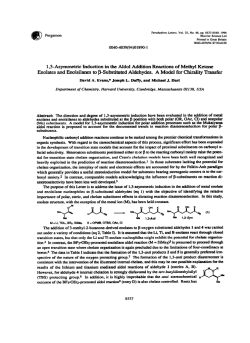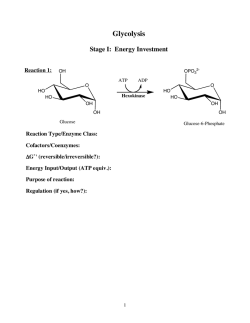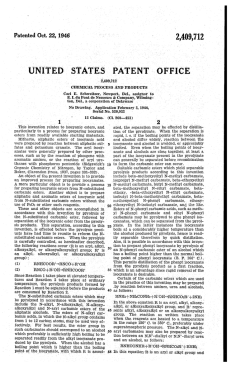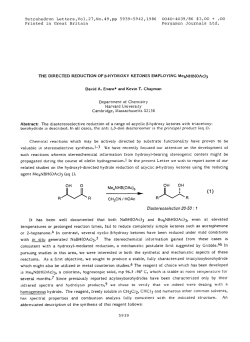
Control of Remote Enoate Geometry in the Bryostatins with a
co4o-403980 $3.00 + .oo Pcrgmon Pressplc TctrahcdronLeucrs. Vo1.31. No.33, p~47034706.1990 Printedin Great Britain Control of Remote Enoate Geometry in the Bryostatins with a Tethered Homer-Wadsworth-Emmons Reagent David A. Evans* and Erick M. Carreiral Department of Chemistry, Harvard University Cambridge, Massachusetts 02138 USA Abstract: The stereochemistry of the exocyclic unsaturated ester at Cl3 of the bryostatins may be established with a tetheredphosphonate reagent anchored to a proximal hydroxyl function at cl6 of an advanced intermediate en route to the total syntheses of the bryostatins. We have been engaged in activities directed towards the total synthesis of bryostatiu 1.2 This fungal metabolite, whose saucture was secured by X-ray crystallography, was isolated as a constituent of the bryozoan Bugula neretina and was found to possess activity against lymphocytic leukemia and ovarian carcinoma. Since the initial isolation work, eleven additional congeners have been extracted from Bugula neritina, and one, bryostatin 8, has been isolated from the bryozoan Amathia convulata.3 Among the various stereochemical challenges posed by this class of polyacetate&rived natural pr&cts is the synthesis of the exocyclic unsahzated esters in rings B and C. In our retrosynthetic analysis, disconnection at the Cl-0 acyl and the C&-C17 olefin bonds reveals two synthons of roughly equal complexity where the Cl-Cl6 portion consists of a Cl-acid and a Ctgahiehyde, and the Ct7-C27 portion consists ofa Cl7 sulfone and a Cu carbinol. H Bryoatatin1 R = O$(CH),(CH#le Bryostatinll R-H F+igure1. Macrocy~lics&ocontmlofEnoateGeometryinBryostatins l& 11. The disposition of the exocyck ester in ring B relative to the derived oxygen function at Cl6 suggests a plan when a primary alcohol at Cl6 would serve as both an aldehyde precursor and anchor for a tethenzd phosphonate reagent. Inspection of the Ct7-C&7fragment reveals a similar spatial relationship between the C21 enoate and the c~alcohol,sothptananalogousstrwgycouldbe~tocontnoltheolefingeonreayatc~tP Thepurposeof the present Letter is to disclose the diastereoselective synthesis of the unsamrakd ester at Cl3 in an e&orated intermediate (Cl-Cla) en mute to bryostatin 1.5 The study ducumnts the use. of a tethezed phosphonate teagent to effect a highly selective and efficient macroOkfinationrractiontoconaOlrambenoategeomeby. 4704 DMAP. m&l.$ @) NaBH& EIDH. 0 ‘c;TlPSOTf, Et&8 pmdwd ID a I:l-mixtwo d (I-TIPS dsrterwmars; 0) K&o,. CMCl2, P ‘c; Q 02, -7S’G Ctl&t: Me& lJRW(OCEt& THF. -78 “c. (i) PDC, twidinlum -0, MeoH. 23% At the outset, we chose a model substrate that would allow us to adequately define various reaction parameters such as tether length, enolization, and cyclization conditions. Preparation of the model system is illustrated in Scheme 1. Reduction of hydroxyketo ester 1 with MedNBH(OAc)s (2.5 equiv, -40 Y!, MeCaH, MeCN)6 provided dio12 (93%. 15:l diastereoselection). Treatment of 5 with KotBu (IIF, 0 “C) delivered 6 as an 861 diastereomeric mixture of cis/trans-substituted tetrahydropyrans 6 as determined by capillary vapor-phase chromatography. The stereochemistry of the substituted tetrahydropyran was established by n.0.e. experiments on the derived diketone 7; irradiation of the axial t& proton (4.33 ppm) led to a 6% enhancement of the axial C2 proton (4.16 ppm). The illustrated four-step transformation of ketone 6 afforded ketone 9 which as utilized in subsequent experiments as an unresolved mixture of OTPS diasdtereomers. Treatment of 9 with a dilute stream of ozone in oxygen (-78 “C!, CH2C12) followed by reductive workup (Mess, 0 “C) provided an unstable ketoaldehyde that was selectively reduced with LiAlH(OCEt~~7 to provide hydroxyketone 10. Acylation of 10 with the tetheredphosphonate reagent 118provided the macrocyclization precursor 12 (eq 1). DCC. DMAP, CH&lz HO&(CH,),OGH+‘O@W~ 100% 10 (1) (11) 12 Several criteria were examined to determine the optimal tether length: overall thermodynamic stability of the product, stemoelecuonic requitements ofthe two estets within the macrocycleP and minimization of unfavorable transannular interactions of the tether with the bridging metbylene. D&ding models suggest that a six-carbon tether engenders a fourteen-member ring with low energy conformations which satisfy the criteria delineated for the desired enoate diastereomer. In an effort to quantify the free energy differences~ of the two enoates, a multiconformational search was executed with the ring-generating molecular mechanics program of StilL1u The 4705 lowest energy conformers found for each geometrical isomer diffued in energy by -10 Lcsvmol (Figum 2). It is A bears both estem in the s-cis oonformatior (O=C-O-C equals 5.8 reassuring that the mote stable diasm for the unsammted estez and 3.5Ofor the saturated ester); in conuastl the less stable tn&cmqcleBpossessesthe unsaturated ester moiety in the S-aans arranmt (O=C-O-C equals 173.80) while the sammtcd ester is pemubed away from the s-cis minimum (O=C-O-C equals 25.1’). In addition, whereas enoate A benefits !hm some degnx of conjugation (O=C-C=C equals 165’). the less stable counterpart B lacks this stabilizing feature (O==C-C=C equals 53“). To the extent that these effects are &kcted in the transition stmcture leading to the macmcycle, the diastereoselection is expected to be high. C-O-C-O dhadml -Ma AGe- AG A 90 MO kcal / dhadml- 3.5 o A 04X-C dhedml-25.1 o B Figure 2. Lowest Energy Stmchues for Cis- and Tram-substituted Macrodilactones. We were gratified to find that treatment of a 1 mM solution of 12 with 33 equiv of lithium chloride and 30 equiv of triethylamine for 36 h a&n&d the de&d macmcycle 13 in 86% yield as a single olefin diastereomer by lH NMR spectmscopy (eq 2). The enoate geometry is supported by n.0.e. experiments; irradiation of the vinyl proton at 5.63 ppm resulted in 5% enhancement at the proximal endooyclic methylene protons at 2.15-2.08 ppm. In addition, mass spectrometric analysis (electron impact) confii that the desired product, and not highmolecular weight oligomem. had been formed in this transformation. Having served its function, the tether was cleanly removed with K2CO3 in methanol (1.2 equiv, 25 OC,36 h) to affo~I 14 (eq 3). (2) (3) A similar cyckation was performed on an advanced intumedkk in the synthesis of the Cl-C16 portion of bryostatin 1 (eq 4). Cyclization of 15 under identical conditions (33 equiv LiCl, 30 equiv Et3N, MeCN, 25 ‘C, 36 h) afforded the M-member dilactone 16 in 60% yield as a single olefin d.iast@eomer judged by 1H NMR 4706 spectroscopy. The lower ylekls obtained as compared to the model system may be atuibuted to elimination across Q-C3 by competitive deprotonation of the Cl ester. Mozwver. methanolysis of the resulting macrocyclic d&tone (Li2CG3. MeOH) selectively transesteriEes the sauna&d ester and provides a primary alcohol. oxidation of the Cl6 alcohol provides the Cl-C16 aldehyde for subsequent coupling to the c17-cn subunit wmz ye P;e Me 7 0 OMEM %iE &N 5 (4) 1mM 609b PMB Oct&oPMB 0 15 15 In conclusion, we have demonstrated that the stereochemistry of the remote unsaturated ester at Cl3 of the bryostatins may be controlled through a macrocyclic oleflnation reaction. Further studies on the total synthesis of bryostatin 1 will be reported shortly. Acknowledgment. This research has been supported by the National Institutes of Health (GM-33328). The NE-I BRS Shared Instrumentation Grant 1 SlO RR01748-OlAl is also acknowledged for providing NMR facilities. References and Notes (1) National Science Foundation Pmdoctoral Fellow, 1985-1988. (2) Pettit, G. R.; Herald, C. L.; Clardy, J.; Arnold, II.; Doubek, D. L.; Herald D. L. J. Am. Chem. Sot. 1982, 104,6846-6848. (3) See: Pet.&, 0. R; Leet. J. E.; Herald, C. L.; Kamano, Y.; Boettner, F. E.; Bacxynskyj. L.; Nieman, R. A. J. Org. Ckm. 1987,52,28542860 and references therein. For those members of the bryostatin family beating a substituent at 0, the geometry of the unsaturated ester (4) at C21 in fact could be expected to be controlled by miniixation of Alg allylic interactions in analogy to literature precedents for substituted cyclohexanones, for example, see: Garner, P.; Ramakanth. S. J. Org. Chem. 1987,52,2629-2631. As an alternative method we envisioned employing modifications of the asymmetric Wittig reaction mportcd (5) by Hanessian, see: Hanessian, S.; Delorme, D.; Beaudoin, S.; Leblanc, Y. J. Am. Chem. Sot. 1984,106, 5754-5756. Since the initiation of this project a similar asymmetric oleiination has been reported with (+)-8phenylneomenthyl phosphonoacetate, see: (a) Rehwinkel, H.; Skupsch. J.; Vorbrilggen, H. Tetrahedron Len. 1988,29, 1775-1776. (b) Gais, H.-J.; Schmiedl, G.; Ball, W.; Bund, J.; Hellmann, G.; Erdelmeier, I. Tetrahedron L&t. 1988,29, 1773-1774. D.A.;Chapman, K. T.; Carreira, E. M. J. Am.Chem. Sot. 1988,110.3560-3578. (6) Evans, (7) Krishnamurthy, S. J. Org. Gem. 1981,46.4628-4629. of 1,6-hexanediol (NaH, THF, (8) The tethered phosphonate reagent was prepared by monosilylation r-BuMe$iC!l, 0 “C) followed by acylation with diethyl phosphonoacetic acid and two-phase Jones oxidation. (9) Wiberg, K. B.; Laidig, K. E.J. Am. Chem. Sot. 1988,110,1872-1874. (10)The calculations were performed with the MM2 force field on a series of structures generated in the multiconformer mode of the MacroModel program generously provided by Professor W. Clark Still, Columbia University. (Received in USA 17 May 1990)
© Copyright 2026
